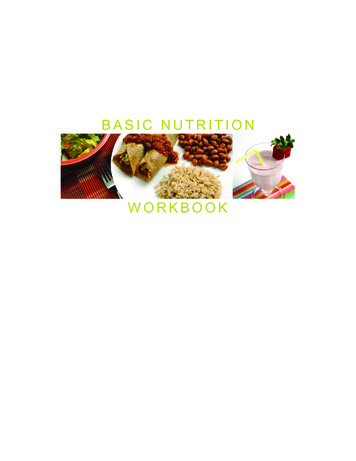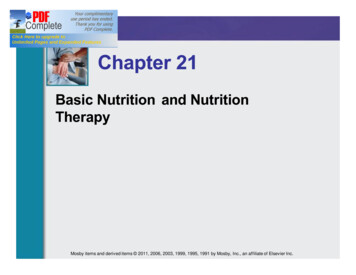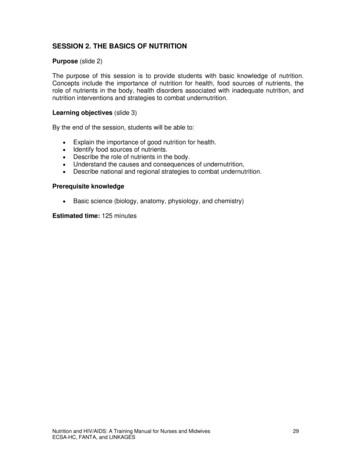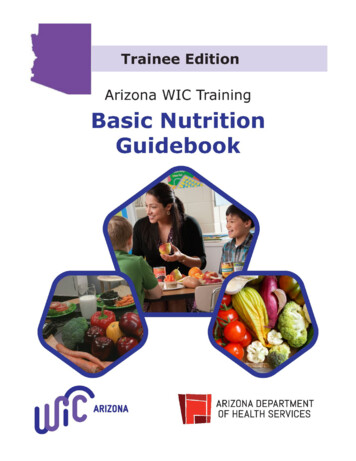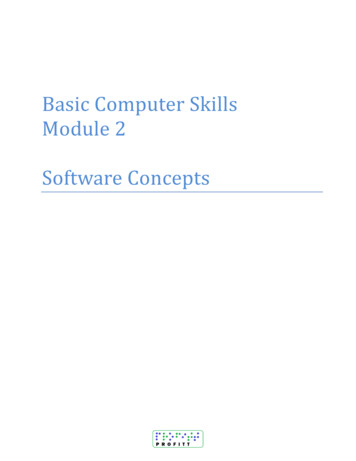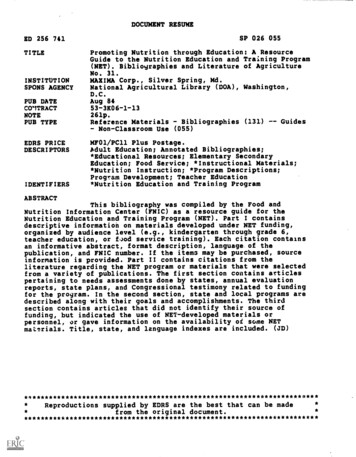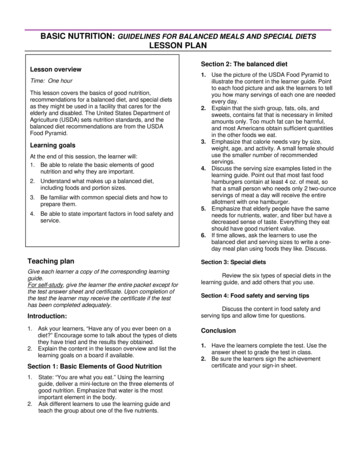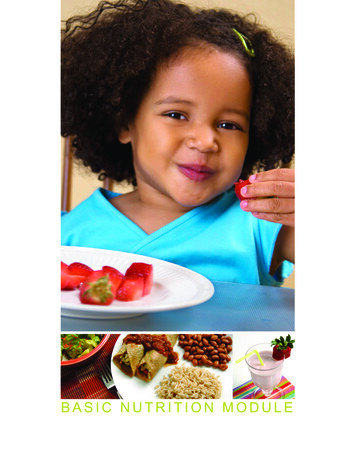
Transcription
BASIC NUTRITION MODULE
Basic Nutrition ModuleContentsPart 1: Setting the Stage — Food, Nutrition,and America’s Waistline. 1-1The Big Picture.1-2Food Economics and Nutrition.1-3The Good News.1-4WIC’s Commitment.1-4What is Your Role?. 1-5Part 2: Nutrient Basics. 2-1The Nutrients. 2-2How Much of Each Nutrient do People Need?. 2-4Which Nutrients Provide Calories?. 2-4How Many Calories do People Need?.2-5Which Nutrients are in Your Foods?.2-7USDA’s National Nutrient Database for Standard Reference.2-7The Nutrition Facts Label.2-7Tracking Nutrient Intake with a Food Record. 2-9Part 3: Carbohydrates, Fats, and Proteins. 3-1Carbohydrates, Fats, and Proteins: Finding the Right Balance.3-2Carbohydrates.3-3Naturally-present Sugars.3-3Added Sugars.3-3Starches.3-5Fiber.3-5Fats . 3-8Harmful Fats. 3-8Healthier Fats. 3-9Cholesterol.3-10Dietary Recommendations for Fats. 3-11Proteins.3-12Food Sources of Proteins.3-12Meeting Protein Needs.3-13Dietary Recommendations for Proteins. 3-15iii
Part 4: Vitamins, Minerals, and Water.4-1Vitamin and Mineral Basics. 4-2Vitamin A. 4-3Vitamin D.4-5Vitamin C.4-7Folate (and Folic m.4-21Dietary Supplements. 4-23Water. 4-24Part 5: Sound Advice for a Healthier America.5-1The 2010 Dietary Guidelines for Americans.5-2USDA’s ChooseMyPlate.gov.5-2The 2008 Physical Activity Guidelines.5-4More Ways to Put Good Health into Practice. 5-8Eat Less, Move More. 5-8Cook at Home More Often. 5-11Dine out with your Health in Mind. 5-11Limit Screen Time.5-12Practice Food Safety.5-12Practice Mindful Eating.5-13Control Your Portions.5-14Making Sense of it All. 5-15iv
Part 6: Your Own Checklist for Good Health. 6-1Being at a Healthy Weight. 6-2Body Mass Index. 6-2Waist Circumference. 6-4What is Your Weight Status?. 6-4Choosing Healthy Foods.6-5Being Physically Active. 6-6Knowing Your Other Risk Factors.6-7High Blood Pressure (Hypertension).6-7Blood Cholesterol, Lipoproteins, and Triglycerides. 6-8High Blood Glucose. 6-9Tobacco Use.6-10Family History.6-10Other Risk Factors. 6-11Setting Goals for a Healthy Lifestyle. 6-11References.R-1Glossary. G-1Answer Key. K-1Tables2.1Nutrient Needs Based on Age and Gender. 2-32.2Estimated Calorie Needs Based on Age, Gender and Activity Level. 2-63.1Approximate Fiber Content of Various Foods. 3-63.2Approximate Cholesterol Content of Various Foods. 3-103.3Approximate Protein Content of Various Foods.3-134.1Daily Vitamin A Recommendations. 4-44.2Approximate Vitamin A Content of Various Foods. 4-44.3Daily Vitamin D Recommendations. 4-64.4Approximate Vitamin D Content of Various Foods. 4-64.5Daily Vitamin C Recommendations.4-84.6Approximate Vitamin C Content of Various Foods. 4-94.7Daily Folate Recommendations.4-114.8Approximate Folate and Folic Acid Content of Various Foods. 4-11
4.9Daily Calcium Recommendations.4-134.10 Approximate Calcium Content of Various Foods. 4-144.11 Daily Iron Recommendations.4-174.12 Approximate Iron Content of Various Foods.4-174.13 Approximate Sodium Content of Various Foods.4-204.14 Daily Potassium Recommendations.4-214.15 Approximate Potassium Content of Various Foods. 4-225.1Calories Burned per Hour in Common Physical Activities. 5-9Figures1.1Prevalence of Food Insecurity.1-32.1Carbohydrate Calories Versus Fat Calories. 2-54.1Most Sodium Comes from Processed and Restaurant Food. 4-184.2Quick Guide to the Best Beverages for Adults. 4-265.1Image of www.ChooseMyPlate.gov . 5-25.2Key Messages from USDA. 5-3Boxesvi2.1Reading a Label in 4 Easy Steps .2-83.1Putting Dietary Ranges into Practice. 3-23.2Whole Grain Basics. 3-73.3FAQs About Protein.3-145.1Examples of Moderate and Vigorous Activities. 5-55.2The 2008 Physical Activity Guidelines for Americans. 5-75.3Balancing Calories for a Healthier Weight. 5-10
IntroductionAbout the Basic Nutrition Module:The purpose of this module is to provide WIC staff withinformation about basic nutrition and current dietary guidelines.After completing this module, staff will be able to express anunderstanding of how healthy food choices, weight maintenance,and physical activity relate to good health. WIC staff will be ableto promote these concepts in daily interactions with clients and beaware of ways to make positive changes in their own eating habitsand lifestyles.The Basic Nutrition Module has two components: 1) the BasicNutrition Module which contains the main text, and 2) the BasicNutrition Workbook, which contains the activities and test questions.How to Use the Basic Nutrition ModuleThis module contains six parts. As you read through each part, thefollowing icons will prompt you to stop and go to your workbook tocomplete the activities and test questions.Activity Icon — When you see this icon, stop where you areand complete the corresponding activity in the BasicNutrition Workbook.Test Icon — When you see this icon in the module, stop andcomplete the corresponding test questions in the BasicNutrition Workbook.Terms that appear in bold type in the text are defined in theglossary in the back of the module. There is a single Reference Listin the back of the module that contains all the references citedthroughout the text.
Setting the Stage — Food, Nutrition,and America’s WaistlinePart 1As a nation, Americans are overfed but undernourished — we’reeating too many calories, yet we don’t always get the nutrientswe need. As a result, our country has record high rates of obesity,heart disease, diabetes, and other chronic diseases. Fortunately,there are programs like WIC that can help.ObjectivesAfter reading Part 1 you’ll be able to: Identify trends related to the health and lifestyle of Americans. Identify specific factors that are leading to weight gainin Americans. Define food insecurity and recognize factors that affect it. Define the term food desert. Recognize the importance of your role as a WIC staff memberin promoting healthier lifestyles.1-1
Part 1The Big PictureAmericans are eating too much saturated fat, sugar, sodium, andcalories, and not enough vitamins, minerals, fiber, and beneficial oils.We’re snacking on packaged foods full of empty calories rather thaneating fresh foods full of wholesome nutrients. And we’re eating onthe run instead of taking the time to cook at home, savor our foods,and enjoy meals with family. Consider these alarming trends andstatistics: Two out of every three American adults are overweightor obese. About 72% of women and 64% of men in the U.S.are overweight or obese. And many more people are at risk ofbecoming part of these statistics (United States Department ofAgriculture [USDA], 2010a). Most Americans don’t get enough regular physicalactivity. Many people get none at all. Only 31% of U.S. adultssay they are physically active on a regular basis, and researchshows that actual activity is much lower than what people report(Troiano et al., 2008). Being overweight or obese puts people at risk for chronicdiseases, including high blood pressure, heart disease, and type 2diabetes. Poor dietary habits have also been linked to osteoporosisand some types of cancer. According to USDA, the number ofdeaths related to poor diet and physical inactivity is increasing andmay soon overtake tobacco use as the leading preventable cause ofdeath (USDA, 2010b). America’s children are learning by example. Theprevalence of overweight and obesity has practically doubledamong younger children, and tripled among adolescents since theearly 1970s. Like adults, kids are eating too many calories, fats andsugars. The top three sources of calories among kids are grainbased desserts (cookies, cakes, pies, pastries, etc.), pizza, and highsugar sodas and energy drinks (USDA, 2010a). Americans spend 45% less time preparing food at homethan before. Processed and packaged foods crowd supermarketshelves, more fast food is available, and Americans are eating awayfrom home more often than before. That means we’re getting moresalt, saturated fat, and additives compared to what we would get ifwe cooked most of our foods at home from scratch (USDA, 2010b).1-2
Setting the Stage Portion sizes have ballooned along with everything else.Today, you can buy a 64-ounce “Mega Jug” soda, which will loadyou down with 780 calories and 217 grams of sugar. This is 10times the size of an original 6.5 ounce Coca-Cola bottle. Worseyet, fast food restaurants and convenience stores typically offerthe large-size portion for just pennies more than the medium-sizeserving, giving consumers more food for their money. But as weknow, more is not always better.Food Economics and NutritionEven though our country is plagued withoverweight, obesity, and overconsumption, thereare still millions of people in the U.S who are“food insecure.” Food insecurity means thereare times during the year that a person may nothave enough money or other resources to getthe food they need. During 2009, 17.4 million ofall U.S. households (14.7 %) were food insecureat some point during the year (Nord, ColemanJensen, Andrews, & Carlson, 2010). Texas is oneof five states with a food insecurity rate higherthan the national average (see Figure 1.1).Figure 1.1 Prevalence of FoodInsecurity, average 2007-09Food insecurity is closely tied to householdincome. Based on 2009 statistics, 43% ofhouseholds below the poverty line had a difficulttime putting enough food on the table at somepoint during the year. Also, 57% of food-insecurehouseholds said that they had taken part in theSupplemental Nutrition Assistance Program (SNAP), The NationalSchool Lunch Program, and/or WIC during the previous month(Nord et al., 2010).Geographic location can also affect a family’s nutrition. SomeAmericans live in food deserts – large geographic areas that don’thave reasonable access to affordable fruits, vegetables, whole grains,low-fat milk, or other healthy foods. Food deserts can be in innercity or rural settings, often in areas where residents have fairly lowincomes. In some food deserts, the closest and easiest places to getfood are fast food chains or convenience stores. People living in fooddeserts are in need of healthier food options (Centers for DiseaseControl and Prevention [CDC], 2010b).1-3
Part 1The Good NewsWhile the big picture looks bleak, America’s nutritional health is nota lost cause. Many people are making healthier choices like cookingat home more often, walking during work breaks, planting gardens,exercising with friends, and playing outside with the kids. And weare not all statistics — many Americans are already at a healthyweight or working toward a healthy weight.Many Americans arechanging their eatinghabits and becomingmore active.Communities and governments are creating initiatives to helpimprove people’s nutrition and fitness. Cities are adding walking andbiking trails and offering recreation programs for kids and cookingclasses for adults. Schools are working with farmers markets andchefs to include more locally grown produce on their lunch menus.National programs like “Marathon Kids” and “Let’s Move America”encourage families to be more active, eat more fruits and vegetables,and have better access to healthy foods. New federal laws requiremany restaurants and vending machines to provide nutritioninformation for foods items.WIC’s CommitmentAs one of USDA’s nutrition assistance programs, WIC helps topromote health and improve food security by providing healthy fooditems to eligible women, infants, and children. In 2009, the programadded fruits, vegetables, and whole grains to the list of WIC foods.WIC also started offering extra food incentives to mothers who fullybreastfeed their infants as a way to encourage more moms to makethis healthy choice.Of course, WIC does much more than provide supplemental foods— nutrition education is a huge component of the program. WICstaff members focus on educating and motivating participants to livea healthy lifestyle. WIC encourages participants to eat more fruits,vegetables and whole grains; cut down on fat and sugar; be moreactive; breastfeed their infants; model healthy lifestyles for theirfamilies; and follow eating patterns that are in line with the latestdietary guidelines.1-4
Setting the StageWhat is Your Role?So what does all this mean to you, a staff member in a Texas WICclinic? First, remember that you are an important resource for WICparticipants. You can make a difference in the lives of many Texasfamilies by helping participants learn practical food and nutritiontips that they will use every day. You can provide them with healthyfoods so they can be more food secure each month; you can helpparticipants understand the benefits of breastfeeding; and you canhelp them learn how their diet and physical activity choices can affecttheir health and their children’s health. This module is the first steptoward learning the nutrition basics you need to know in order to bean important resource for participants.But there is something more to consider about your role as a WICstaff member: your own health. As you go through this module, wechallenge you to think honestly about yourself. Look at your owneating habits, your own activity level and other choices you makeeach day. Take this opportunity to start your own lifetime journeytoward wellness. In the end, we hope this module helps you makehealthy changes in your own life as well as the lives others.Part 1 Test: This is the end of Part 1. Go to your BasicNutrition Workbook to complete Part 1 test questions.1-5
Nutrient BasicsPart 2Nourishing ourselves is no small task — it takes over 45 nutrients tokeep our bodies going every day. In this section, we will introducethe different categories of nutrients and also discuss some practicalaspects, like how to tell what nutrients are in your food, and how tokeep a one-day food record.ObjectivesAfter reading this section you’ll be able to: Identify the six major categories of nutrients. Understand which nutrients provide calories. Recognize which factors can influence a person’s nutrient needs. Practice using a food diary to record your food intake. Demonstrate how to read and analyze a food label.2-1
Part 2The NutrientsThe nutrients our body needs are grouped into six major categories: Carbohydrates are the body’s major source of energy (calories).Current guidelines suggest 45-65% daily calories should comefrom carbohydrates. Fats transport nutrients and are an important part of the cellstructure. Fats also contribute calories — lots of them. ManyAmericans eat too many saturated and trans fats, raising their riskof cardiovascular disease. Experts recommend that 20-35% of ourcalories come from fat. Proteins are made up of amino acids that the body uses to build,repair, and maintain tissues. Most Americans get plenty of proteineach day. The latest guidelines advise getting 10-35% of ourcalories from protein each day. Vitamins are present in foods in small quantities, yet they havebig jobs, helping with chemical reactions in the body. Vitaminsdon’t provide calories, but they help the body use calories fromcarbohydrates, proteins and fat. In this module, we’ll focus onvitamin A, vitamin C, vitamin D, and folic acid. Minerals are similar to vitamins in that they are present in tinyquantities, they don’t provide calories, and they play specificroles in body functions. In this module we’ll cover iron, calcium,sodium, and potassium. Water is an essential part of the diet. Water is part of every fluidin the body; it carries nutrients and oxygen, carries out waste, andnormalizes our body temperature. Our bodies can survive for sixto eight weeks without food, but a healthy adult can’t make it morethan 3 to 5 days without water (Bryant, 2008).2-2
Nutrient BasicsTable 2.1 Nutrient Needs Based on Age and Gender (USDA, 2010a)This table does not include data for pregnant or breastfeeding women.A copy of this table is available in the Appendix of your Basic Nutrition Workbook.MacronutrientsNutrient (units)Protein (g)(% of calories)Carbohydrate (g)Sourceof GoalaRDAbAMDRcRDAFemale9–13Male9–13Female Male Female Male Female Male Female14–18 14–18 19–30 19–30 31–50 31–5051 Male51 �3520–35DGe 10% 10% 10% 10% 10% 10% 10% 10% 10% 10% 10% 10% 10%AMDRTotal fiber (g)Total fat(% of calories)Saturated fat(% of calories)Linoleic acid (g)IOMdCholesterol (mg)Male4–845–65(% of calories)(% of calories)alpha-Linolenic acid(g)(% of calories)Child .11.61.11.61.11.6AMDR 0.6–1.2 0.6–1.2 0.6–1.2 0.6–1.2 0.6–1.2 0.6–1.2 0.6–1.2 0.6–1.2 0.6–1.2 0.6–1.2 0.6–1.2 0.6–1.2 0.6–1.2DG 300 300 300 300 300 300 300 300 300 300 300 300 300MineralsNutrient (units)Sourceof GoalaChild Female1-34-8Male4-8Female9-13Male9-13Female Male Female Male Female Male Female14-18 14-18 19-30 19-30 31-50 31-5051 Male51 Calcium 1,0001,0001,200Iron (mg)RDA7101088151118818888Magnesium (mg)Phosphorus(mg)Potassium 4,7004,700Sodium (mg)ULgZinc (mg)RDA35588911811811811Copper enium (mcg)RDA20303040405555555555555555AI1,200 1,500 1,900 1,900 2,200 2,200 2,300 2,300 2,300 2,300 2,300 2,300 2,300 2,300VitaminsNutrient (units)Vitamin A (mcgRAE)Vitamin Dh (mcg)Sourceof GoalaChild Female1-34-8Male4-8Female9-13Male9-13Female Male Female Male Female Male Female14-18 14-18 19-30 19-30 31-50 31-5051 Male51 515151515151515151515Vitamin E (mg AT)RDA67711111515151515151515Vitamin C (mg)RDA15252545456575759075907590Thiamin flavin in (mg)RDA68812121416141614161416Folate (mcg)Vitamin B6 .50.60.61.01.01.21.31.31.31.31.31.51.7Vitamin B12 line in K (mcg)AI30555560607575901209012090120a Dietary Guidelines recommendations are used when no quantitative Dietary Reference Intake value is available; apply to ages 2 years and older.b Recommended Dietary Allowance, Institute of Medicine (IOM).c Acceptable Macronutrient Distribution Range, IOM.d 14 grams per 1,000 calories, Institute of Medicine.e Dietary Guidelines recommendation.f Adequate Intake, IOM.g Upper Limit, IOM.h 1 mcg of vitamin D is equivalent to 40 IU.AT alpha-tocopherol; DFE dietary folate equivalents; RAE retinol activity equivalent.2-3
Part 2How Much of Each Nutrient do People Need?Scientists routinely look at the latest research to come up withnutrient recommendations for people in different age groups.Individual nutrient needs depend on your age, sex, height, weight,and physical activity, as well as your health status. Table 2.1 listsnutrient needs based on age and gender.Which Nutrients Provide Calories?Only three types of nutrients provide calories: carbohydrates,proteins, and fats. Most foods and drinks have combinations ofthese nutrients in different amounts. Alcohol also provides calories.Alcohol isn’t a nutrient since our bodies don’t need it to function, butalcoholic beverages can add a lot of calories to a diet.Making Sense ofCaloriesSimply put, a calorie isa unit of energy. Thenumber of calories ina food tells you how muchenergy that food provides.For example, an appleprovides about 100 caloriesthat your body can usefor energy.We also refer to calorieswhen we talk about howmuch energy our bodiesuse or “burn.” Example:if you walk 3.5 miles in anhour, you’ll burn about280 calories.2-4Sources of Calories in the Diet: Carbohydrate has 4 calories/gram Protein has 4 calories/gram Fat has 9 calories/gram Alcohol has 7 calories/gramNotice that fat has more than twice the calories per gram comparedto protein or carbohydrate. To help picture this, compare theteaspoons of sugar and oil in Figure 2.1. Because the oil is pure fat, ithas almost three times the calories of a teaspoon of sugar. That’s whybutter, sauces, gravies, salad dressings, and other high-fat foods addso many calories to our diets.
Nutrient BasicsFigure 2.1 Carbohydrate Calories Versus Fat CaloriesTry this! Use MayoClinic’s On-line CalorieCalculator (optional)1 teaspoon of sugar weighs 4 grams4 grams of carbohydrate x 4 calories per gram 16 caloriesThe Mayo Clinic hascreated an online caloriecalculator that tells youhow many calories youneed each day, and alsoshows how different levelsof physical activity affectyour calorie needs.Try it out! Go or/NU005981 teaspoon of oil weighs 5 grams5 grams of fat x 9 calories per gram 45 caloriesHow Many Calories do People Need?A person needs calories for all their body functions (breathing,sleeping, eating, digesting, walking, running, etc). Most women needbetween 1600 to 2400 calories per day, and most men need between2400 to 3000 calories a day. But energy needs vary between peoplebased on gender, age, medical conditions, physical activity and otherfactors. For example, athletes require more energy than non-activepeople. Pregnant and breastfeeding women need more calories thannon-pregnant women. Calorie needs are lower as we get older. Afterage 30, calorie needs decrease about 5% each decade. The good newsis that the more you know about food, calories, and physical activity,the more prepared you’ll be to make positive changes. Table 2.2shows the estimated number of calories a person needs each daybased on age, gender, and physical activity.2-5
Part 2Table 2.2 Estimated Calorie Needs Based on Age, Gender andActivity Level (USDA, November 2010)This table does not include data for pregnant or breastfeeding women.A copy of this table is available in the Appendix of your Basic Nutrition Workbook.Estimated amounts of caloriesa needed to maintain calorie balance for various gender and age groups at three different levelsof physical activity. The estimates are rounded to the nearest 200 calories. An individual’s calorie needs may be higher or lowerthan these average estimates.Age (years)Gender/Activity 02,0002
Basic Nutrition Workbook. Test Icon — When you see this icon in the module, stop and complete the corresponding test questions in the . Basic Nutrition Workbook. Terms that appear in . bold type.

